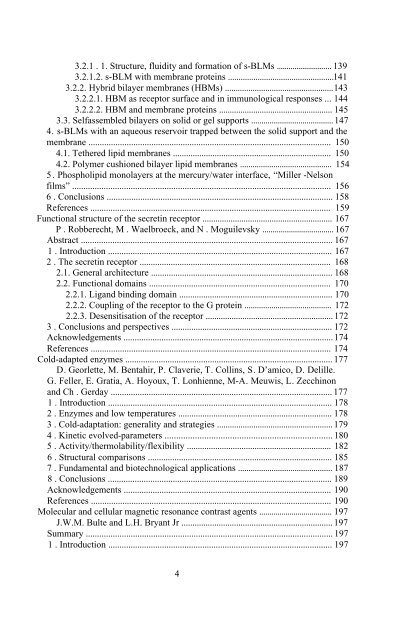Physics And Chemistry Basis Of Biotechnology - De Cuyper - tiera.ru
Physics And Chemistry Basis Of Biotechnology - De Cuyper - tiera.ru
Physics And Chemistry Basis Of Biotechnology - De Cuyper - tiera.ru
You also want an ePaper? Increase the reach of your titles
YUMPU automatically turns print PDFs into web optimized ePapers that Google loves.
3.2.1 . 1. St<strong>ru</strong>cture, fluidity and formation of s-BLMs ............................ 139<br />
3.2.1.2. s-BLM with membrane proteins ..................................................141<br />
3.2.2. Hybrid bilayer membranes (HBMs) ...................................................143<br />
3.2.2.1. HBM as receptor surface and in immunological responses ... 144<br />
3.2.2.2. HBM and membrane proteins ..................................................... 145<br />
3.3. Selfassembled bilayers on solid or gel supports ........................................147<br />
4 . s-BLMs with an aqueous reservoir trapped between the solid support and the<br />
membrane ............................................................................................................ 150<br />
4.1. Tethered lipid membranes ........................................................................ 150<br />
4.2. Polymer cushioned bilayer lipid membranes ............................................ 154<br />
5 . Phospholipid monolayers at the mercury/water interface, “Miller -Nelson<br />
films” ................................................................................................................... 156<br />
6 . Conclusions ..................................................................................................... 158<br />
References ........................................................................................................... 159<br />
Functional st<strong>ru</strong>cture of the secretin receptor ............................................................ 167<br />
P . Robberecht, M . Waelbroeck, and N . Moguilevsky ................................... 167<br />
Abstract ................................................................................................................ 167<br />
1 . Introduction .................................................................................................... 167<br />
2 . The secretin receptor ...................................................................................... 168<br />
2.1. General architecture .................................................................................. 168<br />
2.2. Functional domains .................................................................................. 170<br />
2.2.1. Ligand binding domain ...................................................................... 170<br />
2.2.2. Coupling of the receptor to the G protein .......................................... 172<br />
2.2.3. <strong>De</strong>sensitisation of the receptor ........................................................... 172<br />
3 . Conclusions and perspectives ......................................................................... 172<br />
Acknowledgements ..............................................................................................174<br />
References ........................................................................................................... 174<br />
Cold-adapted enzymes ............................................................................................. 177<br />
D. Georlette, M. Bentahir, P. Claverie, T. Collins, S. D’amico, D. <strong>De</strong>lille.<br />
G . Feller, E . Gratia, A . Hoyoux, T . Lonhienne, M-A . Meuwis, L . Zecchinon<br />
and Ch . Gerday ................................................................................................... 177<br />
1 . Introduction .................................................................................................... 178<br />
2 . Enzymes and low temperatures ...................................................................... 178<br />
3 . Cold-adaptation: generality and strategies ...................................................... 179<br />
4 . Kinetic evolved-parameters ........................................................................ 180<br />
5 . Activity/thermolability/flexibility .................................................................. 182<br />
6 . St<strong>ru</strong>ctural comparisons ................................................................................... 185<br />
7 . Fundamental and biotechnological applications ............................................. 187<br />
8 . Conclusions .................................................................................................... 189<br />
Acknowledgements ............................................................................................. 190<br />
References ........................................................................................................... 190<br />
Molecular and cellular magnetic resonance contrast agents .................................... 197<br />
J.W.M. Bulte and L.H. Bryant Jr ..................................................................... 197<br />
Summary .............................................................................................................. 197<br />
1 . Introduction .................................................................................................... 197<br />
4












